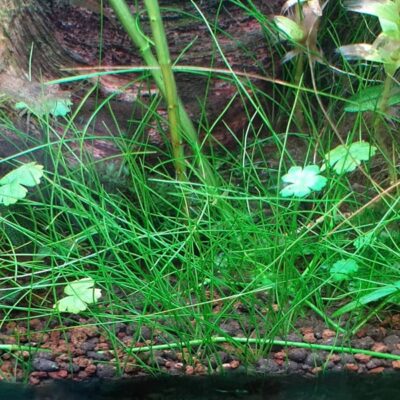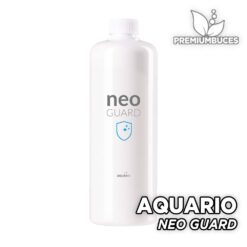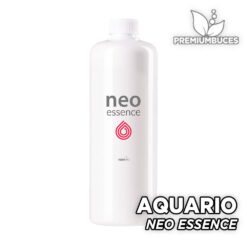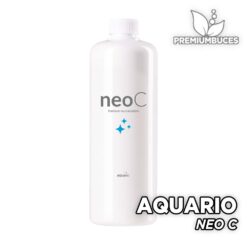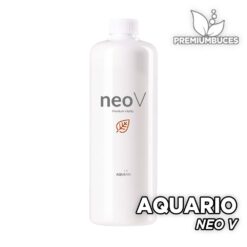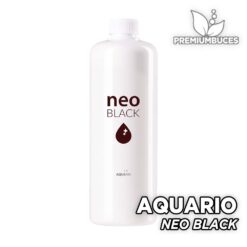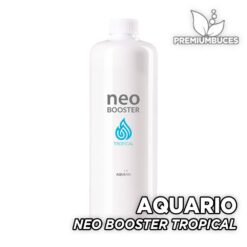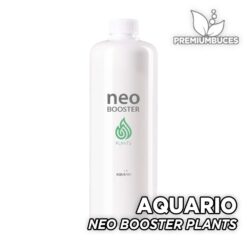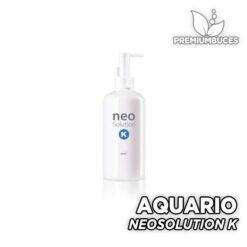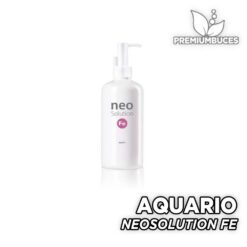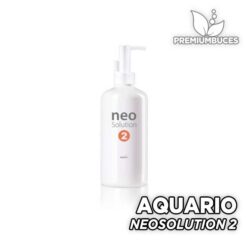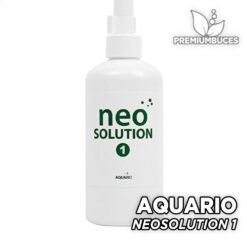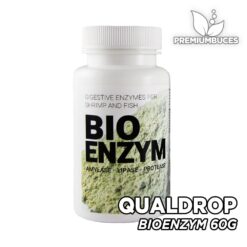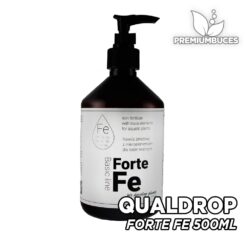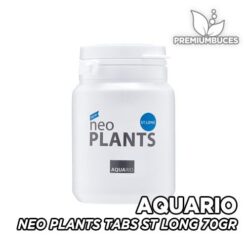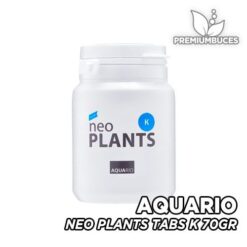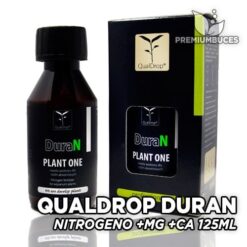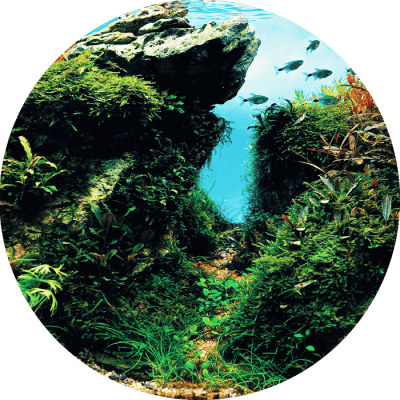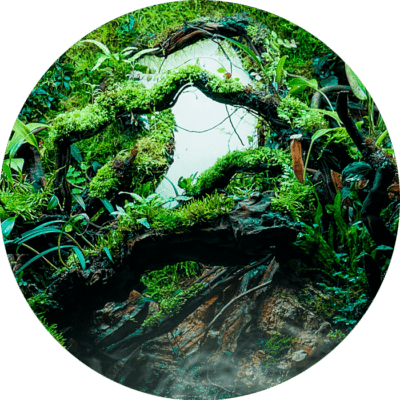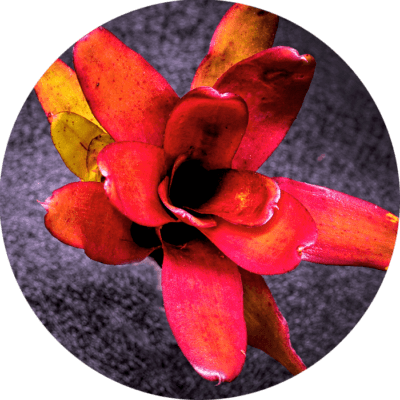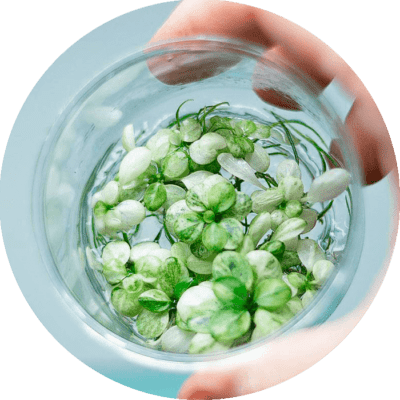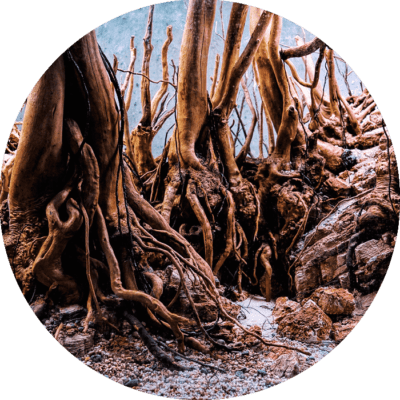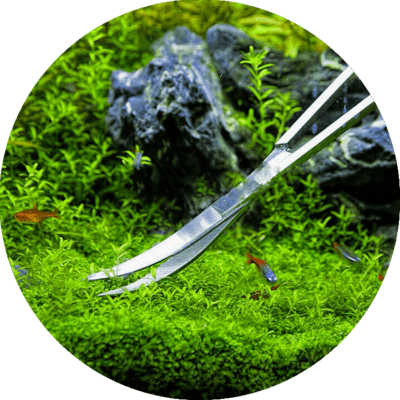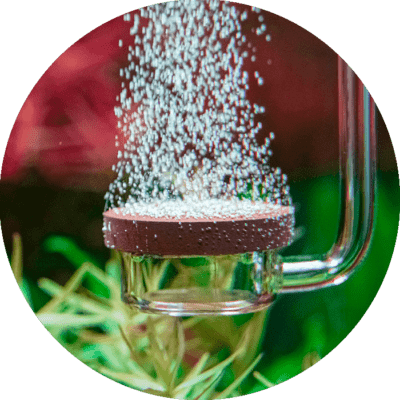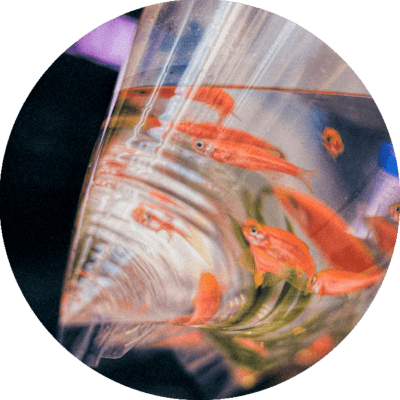Many aquarium fans are drawn to the particular aesthetics of aquariums. asian aquariums. It is true that ancestral cultures Japan have had a very special relationship with the sea and marine creatures, so it is not surprising that home aquariums have all the ordering and care of their ancestors. It is important to keep several focal points in mind to recreate this type of ecosystems in the purest Asian style.
WHAT DOES AN IWAGUMI AQUARIUM MEAN?
When we talk about this type of aquarium we refer to a decorative trend originally from Japan that was used for the internal gardens that were in the buddha temples. With the passage of time, this ornamental style spread to many spaces and ended up becoming a trend that represents an important part of the country culture.
During the 80's, Takashi Amano he was in charge of interpreting nature in a different way. All this philosophy was expressed through the decorative styles in Iwagumi-style planted aquariums. It must be borne in mind that even if it is a very particular and cared aesthetics, you have to bet on natural and simple.
The word Iwagumi is a Japanese term that refers to the order and greatness in the landscaper's work. San, Zon, Iwagumi they mean three things: Torres, Roca, and Agrupación, respectively. This style has become one of the most prevalent aquatic trends in which the minimalist style affirms that more is less.
PHILOSOPHY OF THE IWAGUMI AQUARIUMS
La meditation It is one of the ancient spiritual practices of Japanese culture. The harmony of this practice wants to be transmitted to the world of aquariums through the purism of the natural landscape. In fact, if you look closely at one of these aquariums, you may well remember the typical ones aquatic ecosystems that are in Japan.
Because this is an aesthetic trend that is born in Buddhist temples, the main characteristic of these aquariums is recreate the calm of the ponds and highlight the beauty of the harmony of natural forms.
The main purpose of these aquariums is usually exhibit the beauty of nature by itself, without any extra fancy dress. Ocean life is often a mystery, but this type of aquarium seeks create an environment as similar as possible to ocean life. Although it is not one of the easiest styles, with care and patience, it can be achieved.
Iwagumi, as a whole, means rock formation and these are the protagonists of the entire space. There are somewhat strict rules that these aquariums follow to achieve the ideal of natural beauty characteristic of this culture. The space is divided into two-thirds so that they work like Focal point of all space.
SUBSTRATE OF AN IWAGUMI
The aquarium substrate is where aquatic plants take root. They provide stability and nutrients so that plants can grow. Although some specimens do not need substrate, this is a very important element because contributes to good plant health so they can deal with disease and bacteria.
They also settle bacteria colonies important for filtration. Under natural conditions, the nutrients in substrates vary greatly in their mineral and organic elements and in their appearance and texture. It is necessary to identify the substrate type that aquatic plants need. A recurring problem in home aquariums is that the type of substrate is not what the plants need and they end up suffering because they do not have the nutrients they need.
The plants that most need a substrate are those that absorb their nutritive material through their rhizome. When this is the case in your aquarium, it is very important to have a good substrate so that the plants can nurture and expand according to the average characteristics of its species.
The enriched substrates They have been specially designed for planted aquariums and have a laterite base with an additional amount of organic and mineral matter that is released over long periods of time. There are some substrates with less granulometry to be combined with inert gravel.
There are also some that are designed for not to be used with gravel, but become the single layer of substrate in the background. This is important because these types of substrates do not need to be cleaned as continuously. In addition to being a more practical option, it also provides a look more delicate and aesthetic. They usually have dark or brown colors. It is important to note that aesthetic factors and harmony are very important for a good visual composition in your iwagumi aquarium.
The latest models are designed tohelp keep water parameters stable. This type of aquarium usually needs a lot of attention and care, so this type of substrate can be very helpful.
HOW MUCH SUBSTRATE DOES AN AQUARIUM NEED?
On average, with a layer of nutrient substrate as the only one at the bottom of the aquarium, the thickness should be between 8 and 9 cm at the rear. While in the front of it should be achieved between 4 and 5 cm approximately. However, this is a calculation that depends on the type of plants that will live in the aquarium. When these have a very large rhizome, the thickness of the substrate it has to be tall so that the roots get a firm grip. The plants that create a kind of tapestry on the ground they do not usually need a great thickness, like small plants.
Buy Aquario Neo Soil Plants
The soil type substrates can be very difficult to handle for beginners. Their main problem is that they have many amounts of iron and coal which can be of great benefit to plants, but if you do not have experience with these models, plants can get sick very quickly.
The recommended average layer of a soil type substrate is about 2.5 to 4 cm thick accompanied by another layer of very fine gravel that can be 2.5. You can also use sterile soil solutions, the kind used in pots. This soil has to be specifically recommended for aquariums because the soil that is not sterilized should never be put in contact with fish or aquatic plants.
Usually when you use a soil type substrate, no need to add extra CO2. This is a very important compound for plant photosynthesis, but these substrates have a high content of organic matter. When it starts to decompose, CO2 is released slowly, so an additional one is not necessary. You also don't have to add an iron supplement.
When you start with the substrate, it begins to release many nutrients and organic material. Plants can enter at this point, but fish can suffer a lot because these conditions can be dangerous for your body. Water that has not had its cycling period is deadly to most fish. It is best to wait a few weeks before introducing the fish. This process can also be optimized with a carbon filter. You must keep a check on the water parameters to know when to introduce the fish.
Buy Aquario Neo Soil Plants PowderIf you already have experience with the types of substrate and controlling the quality and quantity of nutrients, we recommend enriched substrates and without any other extra element. You must bear in mind that when the nutritive substrates are the only element, the plants must be able to take advantage of these nutrients from the first moment. In the event that the nutrients are not being used, a chemical imbalance begins to grow in the water chain. A good way to control nutrients is to use an enriched substrate for plants only in the areas where they are located.
If you still do not know how to calculate the amount of substrate you must buy to get 1 cm of substrate, there is a simple calculation that can be very useful. First of all, you must measure dimensions of your aquarium in cm of length, width and height. After this you just have to replace the thickness of your aquarium with the cm of substrate that you think you have. Let's see it with a practical example.
If you have an aquarium of 120 cm long, 50 cm wide and 40 cm high. Let's imagine that the thickness you are looking for for your aquarium is 4 cm. In this case you must supplant the 40 cm of thickness by the 4 cm of substrate what are you looking for. The calculation is as follows:
120 x 50 x 8 = 24.000 cm3 which represents 24 liters of substrate. In many cases, the substrates are identified by measurements in liters, in this case you only have to make a calculation of how many bags of substrate will you need. In the event that the manufacturer does not specify the quantity in liters, you can check with the seller to be sure that you are not missing substrate.
ROCKS FOR AN IWAGUMI
The rocks are a fundamental part of this aesthetic of aquariums. Thinking of an Asian Iwagumi-style aquarium without stones is almost impossible. To achieve symmetry, the rocks neatly according to the rule of two-thirds. It is also important to decorate it with a odd number of rocks. These rules are the best way to achieve good symmetry dividing the zones of space.
Among all the rocks, there must be one that predominates in space for his color, texture or size. The rest of the rocks in the aquarium should be of the same type, but of different sizes to create a homogeneous composition between rocks large, medium and small. The most minimalist version of the iwagumi are the Samsons, which are the most minimalist with 3 rocks in the entire space.
When choosing, you have to choose the mineral well. The stones of calcareous origin cannot be introduced in a freshwater aquarium because alter water parameters. These are stones with sediments that are formed from calcium carbonate, which begins to decompose when submerged in water. This significantly increases the pH and the water ends up becoming harder than what the aquarium inhabitants need.
The only known exception to using this type of rock is when the fish need a pH above 7.5. Otherwise it should not be used in any aquarium. A good way to know if it is a calcareous or limestone rock is to look at the tone. These are usually light colored and with many pores. They can be from white, gray or pink tones.
If you have doubts about whether you are in front of a limestone or not, a good way to find out is using water. You can pour plenty of water over it and if bubbles occur, the stone is limestone or has a limestone composition. This can also occur because it is dirty or has organic material, so it must be cleaned very well before the test.
ROCK POSITIONS IN AN IWAGUMI AQUARIUM

The Iwagumi world has made a series of rock classifications, in order to create good symmetry.
OYAISHI ROCK
This is usually represented as the aquarium head rock and your name means father in japanese. It is the one with the largest size and its shape marks a particular character in the entire space. Although by itself it can decorate an aquarium well, It is recommended to accompany it with other smaller ones to make a better composition.
The average height for this rock is about two-thirds of the total height of the ballot box. As well should be placed two thirds of the full length of the aquarium. In most cases, it is placed at a slight incline to represent the force of water that is capable of moving elements as strong as rocks.
FUKUISHI ROCKS
In the order of hierarchies, this is the second largest and importance. It can be placed accompanying the main stone on its right or left side. It must maintain the same harmony as the whole, that is why it is not good to mix different rocks because the different textures can break the harmony. Fukuishi rock too is positioned at a slight incline, but it may or may not be in the same direction as the main rock.
SOEISHI ROCK
This is the rock next in size to Fukuishi and should be placed on the side of the Oyaishi rock, in this way a composition of three rocks with different sizes. This rock was very important because it worked by highlighting the shape and size of the main rock.
SUTEISHI ROCK
This model also it is known as a sacrificial stone. Although at first glance it seems that it has nothing to do with the larger stone ensembles, they are of great importance. Its function is to create a more homogeneous and complete composition. Having your aquarium with only large rocks can break with the naturalness and variety of natural spaces.
TYPES OF ROCKS FOR MINIMALIST AQUARIUMS
There are several types of rocks for aquariums. Not only do they differ in size or shape, but some can change some parameters of the water. The alterations are not significant and the hardness does not increase too much, this is something that can be solved with a water change. However, if there are fish that are very pH sensitive, this precaution must be kept in mind.
ROCK MAPLE LEAF
Buy Roca Maple Leaf
The coloration of these stones is red and orange hues. It is characterized by having several layers and holes which is a good option to place plants that do not need to be buried in the substrate. Is it is usually one of the first options when you start with an Iwagumi aquarium because it provides more dynamism and a different look to the entire aquarium.
Something that is very important when choosing one of these rocks is that do not disturb the aquarium unnecessarily. It must be remembered that these aquariums usually house species of fish that are very sensitive to changes in parameters. Maple Leaf Stones they do not modify the water chain and can be used without fear of changes in pH. Due to its characteristics, it is recommended as the Oyaishi rock and the main aquarium.
ROCK KEEP STONE
Buy Roca Mantenimiento Stonef
This model has some more pronounced gaps that make the aquarium look great. Their colors go between several gray tones. Due to its cracks, a complex and interlaced look which is very versatile and combines very well with the movement of water in home aquariums.
It is recommended to clean the top with a brush so that the rock maintains its color and appearance. It is normal for a small green layer to form on the surface that can dull the color scheme. Alters the pH level very little, but with some substrates this parameter can be balanced. This type of rock, due to its color and shape, combines well with some types of sand.
ELEPHANT SKIN
Buy Roca Elephant Skin
This is also a great option because it looks great on both its largest and smallest specimens. Their cracks are deeper and your name makes references to the characteristic wrinkles of the skin of elephants. The Elephant Skin allows you to create artistic compositions both on a large scale and in miniature thanks to its crosses between vertical and horizontal cracks.
ROCK PAGODA
Buy Roca Pagoda
This is an inert rock that has a very particular appearance that is very attractive to create landscapes within your aquarium. It has many different contrasts and textures they look great under water and lights. This rock has several layers of color ranging from gray tones to brown tones. The latter give a similar appearance to that of wood.
This type of rocks is very interesting for fish because gives them the impression of living in an environment similar to that of their wildlife. This feeling of familiarity helps avoid stress, which is usually one of the main causes of death in fish.
Remember that fish live in large ecosystems. Although it is a small river, the truth is that there is much more space than they have in an aquarium, so Find places for them to hide when they feel intimidated or to rest. Rocks provide these vital spaces for fish. It can also function as a nest for eggs.
ROCK DRAGON
Buy Dragon Rock Ohko Stone
The dragon rock is also known as Ohko stone y is one of the most popular among aquarium keepers. Your appearance resembles the scales of dragons that are represented in Japanese culture. Also has yellow and gold colorations that look great in the aquarium. This rock has many spaces and craters in which plantations can be rooted. Another of the most interesting features is that they are easy to break to make smaller specimens.
Special care must be taken when handling this type of rock because it is not very resistant to accidents. It has a brittle composition that resembles clay. They are inert stones and have no implication on the water levels.
VOLCANIC ROCK
Buy Lava Stone Volcanic Rock
When lava from volcanoes cools, rocks are formed from these materials that are known as volcanic rock, it is also known as lava rock. It is not only used as an ornamental rock, but can be used to root plants or moss. They have been used for a long time because it is a very accessible material in volcanic areas.
Its use was also recommended because it is a rock with little weight that does not take up as much space and does not subtract as much water from the entire aquarium. Due to its lightness, it is also easy to cut to make smaller pieces. In her cover plant species can be planted and do not alter the water parameters.
ROCK AMANO SEIRYU RYUOH
Buy Amano Seiryu Ryuoh Rock
This was a very attractive stone because it has a black coloring with certain white decorations that give a more lively appearance and with greater movement. Its use in aquatic landscaping has become very widespread because its edges can be pointed or rounded. The surface has a rough appearance where easy to tie plants that can grow without being close to the substrate.
It is good that the sizes vary in this type of aquarium because it gives a greater appearance of naturalness. In water, the stones, even if they are of the same type, do not have the same size or the same finish, so this must be borne in mind when starting with an Iwagumi. Because they contain lime, they can alter the kH or pH level a bit.
PLANTS FOR JAPANESE STYLE AQUARIUMS
Although rocks are one of the most characteristic pieces of Japanese aquariums, it must be borne in mind that its main function is to recreate the beauty of nature. In this sense, it is very important to incorporate plants that can help give a contrast between the hardness of the rocks and the liveliness of the plants.
HEMIANTHUS CALLITRICHOIDES (CUBA)
Buy Hemianthus Callitrichoides
This is one upholstery plant very popular to be used in the foreground of the aquarium. This plant was found by Holger Windelov West of Havana in Cuba. Its growth is moderate and it develops its very vibrant green leaves, but with a tiny size.
This is a plant that is part of the family of the Scrophulariaceae. It grows on the banks of rivers during drought and can be kept submerged to 1 meter during the rainy season, so it is used to a strong stream of water. Although their stems can be held upright, they are very low in height.
Regarding your measurements, it can grow vertically up to 3 cm, but horizontally it is capable of reaching 10 cm and the leaves have a diameter of about 4 millimeters. What's more, it is an excellent species for spawning and eggs. If you have an aquarium planted with lights and a Cuba, it is very easy for you to see the oxygen bubbles that this plant expels.
La ideal temperature where this plant should live is 25 ° C, but it can be spread over a range between 21 ºC and 28 ºC. You should also keep track of the pH so that this value is maintained in the acidic ranges of y entre 5 7.5. With these plants you must keep soft or semi-soft water so that it grows correctly.
Regarding nutrition, requires a fine-grained, enriched substrate to help the delicate roots penetrate with ease. It tolerates high exposure to light well and must have light cycles of between 10 and 14 hours a day. Although the Cuba does not need CO2 supplementation, it can be included together with a fertilizer, which will help it grow healthy and accelerate the growth process.
A health problem that these plants can suffer is iron deficiency and its symptoms are evident if the edges of the yellow leaves are seen. Pruning is important because the old shoots end up on top of the new ones and they have no chance to grow.
Propagation must be done by rhizome division, in this way is that you get the carpet look that characterizes these plants. Another popular way to do this is by cutting sections from a mature plant to plant as a new one in the substrate.
ELEOCHARIS ACICULARIS
Buy Eleocharis Acicularis
Its common name is Spike reed and this is an annual plant that has stems that they grow very long, up to about 15 cm, but in nature, they grow less. When in shallow water it create some small spike shaped flowers on top. The flowers do not usually exceed 5 millimeters
Originally, it has been found in Australia, but it is very likely that it has been introduced, as in water formations in Europe and North America. They have a similar appearance to the Eleocharis parvula, but the Acicularis grows about 15 cm more. Its leaves have a filamentous appearance and its width does not usually exceed a millimeter. It is very aesthetic because it has the appearance of a very interesting vegetable curtain.
La ideal temperature where this plant should live ranges between 22ºC and 28ºC with a pH between 5.5 and 7.5. The water you need should be soft or semi-soft. With respect to substrate, it should be nutritious and enriched with iron. In the event that a nutrient substrate is not used, an NPK fertilizer should be used to help its growth. This plant can grow quickly, but if it is well nourished and with a good amount of light. It is important to do sanitation pruning to maintain the health of the leaves.
The division of the stems is usually the most common way to reproduce this plant. It usually works like a carpet, but with a overgrown grass look with pointed leaves. In these conditions they must be given a good amount of light and carbon dioxide. When these plants are in this position, their growth is medium and does not reach its maximum. Its rhizome reaches a depth of 1⁄4 inch and begins to spread from there.
Asexual reproduction is the most common way to multiply this plant. However, it also se can be done sexually using the seeds that the flowers produce when the plant can already produce the inflorescence in the case that the physical and chemical environment are ideal. Pollination and fertilization of the sex cells helps the seeds to appear that can be dispersed throughout the aquarium and enter the substrate to develop and complete as an adult plant.
If you want them to have a greater presence and a more interesting visual appeal, it is to plant it in a group with a separation of between 2 and 5 cm. I also know it is usually combined with glossostigma or riccia so that it is better attached to the ground as a vegetable tapestry. You have to be careful with algae because it is possible that they grow on the leaves of the plant.
If the rhizome is vertical, its growth will be slower and are often prone to iron chlorosis that affects their normal development. It is easy to identify this disease by the yellow coloration in the veins of the leaves, especially in the new leaves, but in advanced stage the old leaves also begin to get sick.
HYDROCOTYLE LEUCOCEPHALA
Buy Hydrocotyle Leucocephala
This plant is also known as caps that is recommended to give a very natural and soft touch in the aquarium. It is part of the Apiaceae family and it can be found throughout South America, but looking for intermediate climates that are not too cold or too hot. It is a marsh species that it can live well both emerged and submerged.
It is easy to distinguish this plant from the others because its leaves form a kind of hat. Has circular appearance and slightly wavy edges that are interspersed creating the image by which it is commonly known as an umbrella. Its usual size is usually between 3 and 5 cm in its adult stage. Do not be confused with the robust appearance that such plants present in their stems and ramifications, behind this are fragile plants that require care.
In the center of the stem are the buds from which new branches are born. With the passage of time, these branches go outside in search of more light. Its leaves have a light green hue, but you can also find some leaves with a darker tone. These tend to have more leaves, but over time they will fall off because they are from the newly emerged Hydrocotyle group.
There is another group of these plants, but that has its origin in the waters of Europe that was called Hydrocotyle vulgari. It is difficult to distinguish between the two and it is grown in a marsh form with its stems out of the water. This species can get used to living completely submerged in your aquarium, but it tends to grow creepingly and does not reach that high.
It can be adapted very well in cold water aquariums, but you must be careful with fish such as goldfish that really enjoy eating their leaves. Both plants can be located in the front area as a lawn, but requires an acid pH and a lot of exposure to light so it should not be placed under other plants that can function as a filter. Although it can be integrated into tropical aquariums, it is very likely that with the passage of time its leaves begin to fall and disappear.
It is normal for the caps to bury themselves on the bottom of the substrate and end up digging it up a bit. It is also very common for the leaves that are closer to the substrate to begin to turn yellow.; It is not about chlorosis or a disease, this is a natural process in which these leaves end up rotting.
It is best to plant it in different areas dividing its rhizome. It can also be rooted in objects such as rocks. It is important that the aquarium has a height that exceeds 35 cm so that it can develop without problems. You should also be aware of the leaves, because these are the areas where algae can nest.
Burrowing fish and plants can end up damaging the roots. In a similar way, big fish end up damaging it. Herbivorous fish are a danger to these plants, because although these animals do not eat all plants, this is a species that they enjoy keeping in their diet. To ensure that they grow healthy, they must be fertilized with liquid iron or in the substrate.
SAGITTARIUS
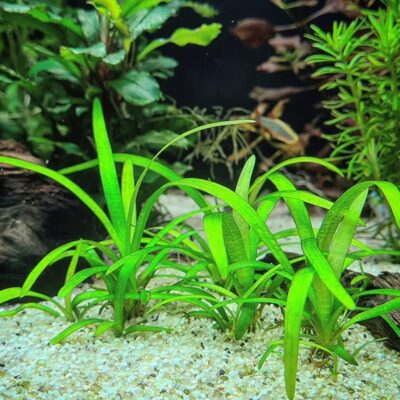
Buy Sagittaria Subulata
If the leaves are kept out of the water, but with the stem submerged and feeding on the water chain, can be reproduced through flowers. Sagittaria flowers are capable of producing female flowers that have seeds and male flowers that can be used for reproduction.
La Sagittaria has three great exponents in plant stores and nurseries, it is the Sagittaria Lorata, the Subulata and the Japonica. In the case of the Lorata grows larger than anyone and can reach up to 90 cm long and due to its length and appearance, it is confused with the Vallisneria Spiralis. For its part, the japonica can grow completely submerged and its size reaches 60 cm, although it has quite a similarity with the Sagittaria Subulata.
The original waters of this plant are those of North America y found in deep water, so it can be kept completely submerged in your aquarium. After being discovered, it began to become popular with great decency and reached Asia, Africa and Europe.
The average range where this plant should live is between 22 and 27 ºCAlthough it is a resistant plant that will not suffer excessive damage if it is subjected to slightly higher or lower temperatures. In any case, the ideal is to maintain a stable temperature to preserve the health of the aquarium inhabitants. It grows very well when it is in acidic waters with a pH range between 6 and 7. Soft waters are the best scenario for them, although they can live in slightly hard waters.
At the time of planting, a nutritious substrate must be provided as compost. The roots are small and delicate, so care must be taken during planting. After the root has been installed, the edge of the leaves should be pulled a little so that the stem part is out of the substrate. It is important to plan the space where this plant will be placed because its leaves have a rapid growth. Although it is not a wallcovering type plant, if it has good lighting they can cover a part of the substrate where they are planted.
Iron fertilizer is very important to prevent the leaves from suffering from chlorosis. This is a very important mineral that helps its growth and enhances the placement of the leaves.
So that this plant can grow, needs good exposure to light. The position in the foreground will help you greatly to receive the amount of light you need. The variety of the Sagittaria Subulata may be particularly susceptible to an algae attack when they have a lot of light. In this case, it is recommended to adjust the light intensity. Algae-eating fish are also a solution that could help eliminate algae, while maintaining good leaf growth.
FISHES FOR AN IWAGUMI AQUARIUM
Fish too They are very important and they have a significant role that represents movement. However, you must choose gregarious and small fish. The fish must represent the unity of the entire composition. The most individual fish can create separate spaces that break up everything you've created up to this point.
According to Takashi the iwagumi aquarium pretends to represent a flow that connects the life of the fish that ends and the stillness of the rocks that remain for a long time. Between these two forms of beauty; the beauty of movement and the beauty of stillnessIt is important to highlight the beauty of the rocks, so look for fish with smooth movements and calm temperament.
CARDINAL TETRA

The scientific name of this fish is Paracheirodon Axelrodi, but it is commonly known as Cardinal tetra or cardinal fish. It is part of the characid family and is a close relative of piranhas, although it is not as aggressive in character. It was documented and discovered in 1956, but despite the time they have been in the books, they are still a species that arouses the curiosity and interest of amateur aquarist scientists.
They enjoy swimming together, so it is not uncommon to see them in groups throughout the aquarium. They have an active character and like to have enough space to move. It is one of the smallest freshwater species and when they reach their adult stage they usually do not exceed 5 cm in length. Its body is quite elongated and its large and lively eyes stand out on its head. In fact, almost all of your head space is devoted to your visual organs.
Their fins are transparent, But his body has a very intense reddish coloration reminiscent of neon tetra, but have a brighter color that covers the entire ventral part. After several genetic crosses, you can find cardinal tetras of gold, silver and albino colors. Their entire body is traversed by a green or blue stripe that distinguishes them between all the species that share the same colors.
Sexual diformism is quite ambiguous in their youth stage, but when they are adults and begin their reproductive activity, there are slight differences between males and females. Females are larger and rounder than males.
They are native to the northern areas of South America, especially in the Negro river basin and its other tributaries. It can also be found in the vicinity of the Orinoco River in Venezuela, but the appearance of the fish in these areas have slight morphological differences with their relatives of Brazil.
They like to live in forest streams where you have a slow, gentle stream of water. The substrate in which they live is enriched by all the leaves, branches and litter that fall from the trees that are immediately found. Due to all the decaying plant matter found in these waters, its coloration is quite dark. They are also water with an acidic pH level.
It is important to provide them with an aquarium of about 50 or 60 liters where they can swim in the middle zone. This is a kind highly recommended for iwagumi aquariums because these fish need abundant vegetation, especially thin-leaved plants where they can find shelter, especially when they are in the breeding stage.
The ideal temperature is between 23 ºC and 27 ºC the ph should lean to acidic waters between the 4 and 7. GH should be among the 3 and 6. These are fish of good appetite and accept almost any food, as long as it is small. When they meet on the riverbanks they usually eat invertebrates, crustaceans, algae and fruits that fall from the trees. When they are at home, a similar diet can be followed with live foods such as brine shrimp, mosquito larvae, and daphnia.
ARQUELIN FISH

The harlequin it is a fresh and warm freshwater fish which is part of the family of Cyprinids. Its scientific name is Heteromorpha trigonostigma and its first categorization occurred in 1900 when it began to form part of the freshwater fish that live in domestic aquariums. One of the characteristics that has made it very famous among aquarium keepers is that it is a fish easy to care for and resistant to diseases.
This it is a very sociable species that can live with other fish in your aquarium. Not only can it be worn with fellow species, but also adapts well to other small fish. There are several varieties of harlequin fish that you can find like the the rasbosa harlequin that has a golden coloration and the black rasbosa harlequin and the blue rasbosa harlequin.
Product of the genetic cross that has been had to obtain different colors, there are morphological differences among the colored harlequins. If you have your small aquarium, it is a highly recommended fish because it is a very small species that only reaches 3,2 cm in length when they are in the adult stage. Although when they are in wildlife they can measure up to 4,5 cm.
The usual color that the first harlequin fish is a variety between red, pink and orange with a black stripe that passes through the dorsal fin, up to the middle of the base of the tail fin and forms a kind of triangle. Your skin tone can be altered by several factors. The quality of the water, the state of health of the fish, the stage of reproduction and the state of mind can create a coloration different from what the fish normally has.
Its body is oval with a compression on the lateral ends. Because it is a fish that feeds on the surface of the water, his mouth is tilted up. Sexual diformism is difficult to differentiate, although the male is slightly smaller and thinner than the females. The triangular mark is another way to distinguish it because in females it is brighter.
Naturally, these fish can be found in Thailand, Malaysia, Singapore, Borneo, and Sumatra. The water in which they live has a lot of vegetation in the areas where they are found. Water usually has a smooth and slow flow with a slightly acidic pH. To recreate its natural habitat, a nutritious and dark substrate should be sought with an aquarium of about 100 liters with shady areas to hide in. The temperature should be between 21 ºC and 28 ºC with a pH between 5 and 7.5.
The little ones worms, insects and zooplankton they are usually their main source of food in their wildlife. In the aquarium you must mix a diet of plant species and frozen foods like some worm or Artemia.
corydoras
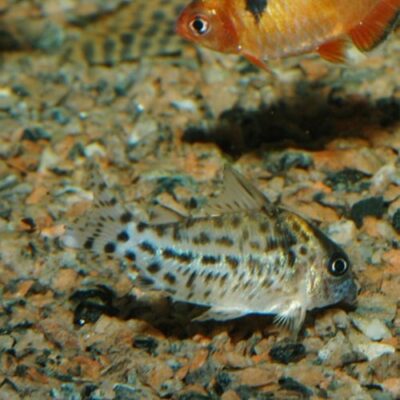
Corydoras are part of the fish siluriform actinopterygians of fresh water. Although other species of this same family have evolved a lot over time, the corydoras have maintained greater uniformity. They are fish that originate in the Paleocene epoch, which that makes them very strong and they adapt very well to waters that do not have as much oxygen.
The Corydoras they enjoy the lower area of the aquarium very much and do not have conflicts with fellow species or other fish. They are very efficient when it comes to keeping the aquarium clean because eat the food scraps of other fish, which helps to prevent them from decomposing in the substrate.
It is important to keep several fish with the Corydoras, especially a school that includes 5 to 6. When these fish have no company, they often suffer from inactivity which is not common in this species, they can also suffer from stress and other illnesses from being alone.
The ventral area of these fish is usually flattened, while the dorsal area is more convex. Its shape is elongated and the eyes are on the top of its head. Behind the dorsal fin we can find a small adipose fin characteristic of the Callichthyidae species. The pectoral fins are very important and function at the time of reproduction.
These fish do not have scales, but instead have two rows of bony plates that cover and protect them in the areas of the flanks, the back and the head. Its name comes from these bone layers because it comes from the Greek where Kóry (helmet) and (doras) skin.
Your greatest resource when looking for food at the bottom of the aquarium are their beards. These are located on the lower chin and with them you can develop a great sensitivity to look for food, this is why your mouth has a slight downward inclination.
Their swim bladder not only helps them stay still without having to swim, but also they can breathe atmospheric air that will then process it in the stomach to end up being expelled in the form of gases. That is why sometimes you can see these air bubbles coming out of them, it is usually a symptom that there is too little oxygen in the aquarium.
Its size can vary quite a bit between all species. when they are maids in captivity they measure between 3 and 6 cm, But in its natural habitat you can find specimens that grow up to 14 cm. Usually does not have a very agile swim, so prefer calm and slow waters.
Finding the differences between males and females is very difficult at first glance. Females are larger and have a more pronounced belly, but this is a trait that is noticed when they are adults or when they are in the reproductive stage.
The color that predominates in his skin is usually gray, but they have very characteristic metallic stains. These spots can be green, yellow, black, blue, or purple. Some species may also have some wavy-shaped stripes found on the head and upper back.
With the passage of time, corydoras began to be found in almost all of the world. As a native species, are found in the areas of South America and Central America. In most cases they are found in river basins Amazonas, Orinoco or on the coasts of Guyana and Suriname. In all the marine extension that goes from Argentina to the north of Venezuela, Corydoras can be found.
The waters where you swim are warm and shallow, but they adapt very well, to the point that they can live in more tropical areas or in colder waters. In fact, in regions that register very low temperatures like Patagonia, you can find Corydoras.
For a group of corydoras you have to maintain a aquarium of about 70 liters, although some species need bigger places and others smaller ones. All this depends on adult size that I get to have. In any case, the smallest aquarium they can live in is 60 liters.
So that this fish can live healthily you need an aquarium with a soft gravel bottom with some elements because this is the area where they usually live. A powerful filter must be maintained because nitrogen compounds are very dangerous, especially ammonia.
The pH in which they must live is y entre 6 7.4 with a temperature between 23 ºC and 26 ºC. The diet should be based on many proteins that can come from frozen foods such as brine shrimp, larvae, mosquitoes, worms. They should also be provided with plant-based foods such as spirulinas. There are food solutions specially prepared for groundfish that you can integrate into their diet; one tablet for every 3 fish will suffice.
Corydoras not only enjoy the company of other fish, they need them. They should never be alone because they will die very soon. Because they are bottom fish, it has no territorial problems and they are very peaceful. Small fish community aquariums do not have a problem with Corydoras, but care should be taken that the tankmates are not too large because they may end up eating them.
Other fish family of the Cyprinids, Characins and other Catfish with a calm character can be good companions. Panda Corydoras can be somewhat more active and sociable than most of their genus.
CARE AND MAINTENANCE OF AN IWAGUMI AQUARIUM
NITROGEN CYCLE
To start an aquarium, the first step is the nitrogen cycle. This is a biological process in which nitrogen, as a chemical compound that is part of all animals and plants, becomes ammonia (NH3) and ammonia (NH4) which is a much less dangerous compound for the aquarium. When oxygen is present, aerobic bacteria transform ammonia and ammonia into nitrites and nitrates, nitrates being much less toxic. This is the process known as nitrification.
When there is not enough oxygen, the number of aerobic bacteria is low and there is no factor that makes toxic agents more tolerable for plants and fish. Anyway, the nitrite level in the aquarium should never exceed 0.21 milligrams per liter. For this process to take place, you should wait at least two weeks in a new aquarium.
WATER CHANGE
The water change has the function remove waste and nutrients that have not been absorbed because an accumulation of these creates an imbalance in the aquarium. During the first 3 weeks, the aquarium is more sensitive to toxic agents, so it can be change the water twice a week with 50% new water. After this with acChange of 30% of the weekly water will be enough.
When you do a water change, it must be clean and free of chlorine. It should also have the parameters of the rest of the water, especially the same temperature.
For any other question, or explore more about the world of aquariums and fish, you can visit our blog.
Other articles of interest may be:
How to Eliminate Aquarium Algae - Causes and Most Effective Treatments
Caridines and Neocaridines - File and Care Aquarium Prawns
In our online store you can buy Accessories to start assembling your aquarium and receive them in 24 hours in Spain.











